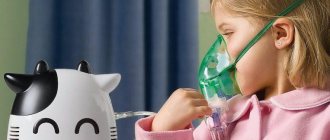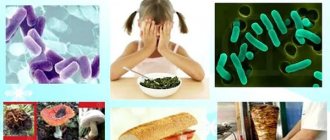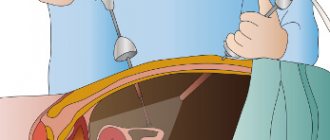Those who have children know firsthand how carefully you need to monitor what your baby eats. The child’s body reacts more sharply to unusual and low-quality food, pathogens of intestinal infections, toxic substances and pesticides and other undesirable “components” that we risk consuming with food and drink. And young children, who do not understand what is possible and what is not, explore the world through sensations, including taste, and therefore strive to try everything new and interesting that they come across on the floor, on the street, in general, everywhere. Therefore, in infancy, children very often experience poisoning, both infectious and ordinary. However, vomiting in a child is not necessarily a consequence of poisoning. Let's look at the main reasons.
Causes of vomiting in a child
A child may vomit for the following reasons:
- poisoning: food, drug, chemical, gas, infectious (for example, rotavirus),
- reaction to unusual, new, inappropriate food, medicine,
- force feeding,
- diseases of the central nervous system,
- diabetes mellitus and other metabolic disorders,
- diseases of the gastrointestinal tract: ulcers, gastritis, gastroduodenitis, gastroenteritis, cholecystitis, pancreatitis, biliary dyskinesia and others,
- diseases of the endocrine system,
- diseases of the central nervous system,
- renal or heart failure,
- acute appendicitis,
- infectious diseases.
Fortunately, most cases of vomiting in children are caused by various types of poisoning and, if proper measures are taken, do not leave behind negative health consequences. It is very important to know what to feed a child after vomiting and what can be eaten during the recovery period, since the body must “rest” from the stress it has experienced and at the same time receive all the necessary microelements and vitamins.
Diet
After poisoning, it is useful to use:
- Curd mass (no more than 20 g per serving).
- Vegetable puree (zucchini, broccoli).
- Low-fat soups with secondary broth.
- Products high in protein (chopped boiled lean meat).
- Baked or steamed foods.
Important! In case of poisoning, a child needs to eat often, but in small portions - 7 times a day with an interval of 2.5 hours.
Every day the amount of food will increase slightly and your appetite will improve. The usual diet will return on the 5th day after the illness. To remove all the consequences after the disease, the diet must be followed for several more weeks. Children 6-7 months old can cook milk rice or buckwheat porridge. Dilute the milk halfway with water. If complementary foods have just been introduced, you need to temporarily remove all vegetable purees and feed only milk, then gradually reintroduce the previously introduced foods again. For children 7-8 months old, meat soufflé and vegetable puree are added to the diet. If vaccination is prescribed within two weeks after poisoning, it is necessary to notify the doctor about the past illness. It is also recommended to take a general blood test and urine test a few days before vaccination. The main thing during the recovery period is to remember that the food is low-fat, properly prepared and easily digestible. In case of poisoning, you should never force someone to eat, but you must monitor your fluid intake.
Vomiting is a natural reaction of the body to poisoning. In children, it occurs when they eat low-quality food or food that the body cannot digest. Vomiting can also occur as a reaction to elevated temperature. In this case, it will stop as soon as the fever subsides. After you have managed to cope with vomiting, you need to take care of proper dietary nutrition to help the body overcome the consequences of poisoning. Diet is especially important in case of vomiting accompanied by diarrhea, because this can lead to dehydration. What to feed a child after nausea, how to support a weakened body?
Feeding a child after vomiting
First of all, you need to know what caused the vomiting. Therefore, we strongly advise you to call an ambulance if your child is vomiting. The exception is cases of single vomiting, when you know exactly what caused it (for example, the child overate). In other cases, an ambulance is needed to rule out the above diseases and poisoning with some dangerous substance. For example, many children die or suffer serious damage to their bodies due to drinking bath soap or other household chemicals. Despite the fact that for different types of poisoning and other diseases that are accompanied by vomiting, diets vary, there are general principles of nutrition during vomiting and in the coming days after.
First day (food for vomiting)
What to give your child after vomiting? The main rule is to provide the child with enough water. Vomiting is often accompanied by diarrhea, and the body loses fluid. You need to drink water little by little, but often, in small sips. Boiled water (from a filter or “canister”, but in no case from the tap) and still mineral water are suitable. You can start giving something other than water only after making sure that the child’s condition has returned to normal, the vomiting has stopped, and the tension in the abdomen and cramps have gone away. Then you can give your child dried fruit compote - an excellent source of vitamins and microelements. A rosehip decoction will also be useful, but it is better to give it when the child has already tried such a decoction.
In the near future after vomiting, even if the condition has stabilized, it is better to limit yourself to compote and water; this regimen can be followed for up to a day without harm to the baby’s health. Usually food is given a few hours after the vomiting stops, and, of course, at the request of the child. Don't give him food if he doesn't want it. Liquid dietary porridge (oatmeal, rice, buckwheat) is what a child can eat after vomiting, after some time. You need to add food a little at a time, literally a tablespoon at a time, taking breaks of 2-2.5 hours.
What to feed a 2 year old child after vomiting stops?
In order for the digestive system to return to normal faster after poisoning and infection, it is necessary to temporarily exclude cold and hot, as well as fatty foods from the diet . It is necessary to create a menu for a 2-year-old child with an emphasis on restoring the functions of the digestive system. During the first two days after vomiting stops, you must adhere to the strict diet described above.
In other words, the child should drink a lot of fluids and rice and oatmeal decoctions. You can give food only on the second day. As a first meal, he can be given low-fat curd mass, yogurt without additives, and pureed bananas. On the third day, low-fat soups, vegetable puree, well-cooked rice, rolled oats and buckwheat porridges are added to the menu. Also during this period, in order to speed up the restoration of the functions of the digestive system, you can give the child low-fat kefir and yogurt.
If parents have any doubts about the possible impact of a certain product on a weakened child’s body, they should first consult with a specialist.
Second day after vomiting
On the second day, in addition to cereals, you can start giving your child pureed baked apples and boiled vegetables such as carrots and broccoli. Food should be made liquid, processed in a blender, to relieve the digestive system. In addition, food must be boiled or steamed, with the exception of bananas, which can be eaten as raw puree. A piece of soaked biscuits or homemade white crackers will not be harmful. The portions are still small, with a break of 2.5 hours. The child may develop an appetite and may ask for something more or more without being able to eat as much food. This is normal and means he is getting better. But you should not make any mistakes in your diet so that the delicate mucous membranes of the stomach and intestines do not become inflamed again. As a drink, you can add chamomile tea to your diet, which has an anti-inflammatory effect and helps improve the functioning of the digestive system.
Third day after vomiting
On the third day, fruit juices are added to the diet. Ready-made baby juices without any additives from manufacturers who also make baby purees will work well. Portions should be gradually increased, but it will be possible to return to the usual amount of food no earlier than on the fifth day. If the vomiting was due to overeating, was a reaction to medication, and was not accompanied by frequent loose stools, you can include baby cottage cheese and yogurt in the diet, and cook porridge in milk and water (1:1). If the child has had poisoning or rotavirus, dairy products are added later, on the 5th-6th day. On the third day, vegetarian vegetable soups are added, maybe cereal soups or with the addition of a small amount of vermicelli (it should be well boiled). It is allowed to cook fruit jellies with starch, but not sour ones. Also, if the child already eats meat and fish, they are added boiled or in the form of a soufflé. It is better to use rabbit or poultry and lean fish, such as pike perch. Of course, don’t forget about “vitamin cocktails”: rosehip decoction and dried fruit compote should be drunk every day.
General rules
Vomiting is an involuntary (reflex) process of simultaneous contraction of the diaphragm, stomach muscles and anterior abdominal wall, leading to the ejection of stomach contents.
In most cases, this process is preceded by increased salivation, nausea, and deep and rapid breathing. Vomiting is part of a symptom complex of a wide variety of diseases - food poisoning, gastrointestinal diseases, infectious diseases, surgical diseases, head injuries, central nervous system pathologies, stress (psychogenic vomiting), and can also occur during teething, overeating, consumption of irritating foods (spices, seasonings). ). Vomiting is especially common in children of all ages. The treatment tactics and nutrition of the child after vomiting are largely determined by the nature of the vomiting and the accompanying symptoms: single/multiple vomiting, connection with the child’s eating/feeding, the amount and nature of the vomit, the presence of impurities (bile/mucus), whether vomiting is accompanied by stool disorder, elevated temperature, pain, whether the child’s general condition is suffering (lethargy, apathy).
Nutrition after vomiting in a child under one year old
The general principle of nutrition for children under one year after a single vomiting and in the absence of fever, diarrhea and abdominal pain is:
- Maintain a short “hungry” pause (3-4 hours).
- Feeding the baby regular food (breast milk/formula). All types of complementary foods are excluded from the diet.
- Reducing the daily volume of food by 1/3 with increasing frequency of feedings (every 2-2.5 hours).
- The missing volume is replaced with liquid.
- In the absence of repeated vomiting, from the 2nd day the volume of food is gradually increased and on the third day brought to the age norm by introducing complementary foods that the child received before vomiting.
Older children, after a single vomiting and in the absence of fever and stool upset, also need to limit the menu with sufficient fluid intake. During this period, on the first day after vomiting, it is recommended to give the child semi-liquid rice, oatmeal, buckwheat porridge, white bread croutons, boiled vegetables, boiled eggs, and fermented milk products without additives. The next day, if vomiting does not recur, you can carefully expand the menu and increase the amount of food, but do not overfeed the child.
In cases where the child has repeated bouts of vomiting, diarrhea appears and the temperature rises, it is necessary to find out the cause of these symptoms and conduct additional examinations. Most often, such symptoms are characteristic of food poisoning caused by the consumption of poor quality food.
The diet for vomiting in a child caused by food poisoning should be aimed at:
- Reduced intoxication.
- Preventing/eliminating body dehydration and restoring electrolyte balance.
- Sparing the gastrointestinal mucosa.
- Normalization of digestion and restoration of normal intestinal microflora.
The diet of children under one year of age who are on mixed/artificial feeding should begin with a fasting break of 5-6 hours, during which the child is given only liquid in the form of herbal tea with sage, linden chamomile, rosehip decoction, boiled water, and dried fruit compote. Then, in addition to breast milk, the diet includes rice water or adapted fermented milk mixtures. In the first 3-4 days after the onset of vomiting, it is necessary to reduce the amount of food taken by 15-20%, replacing the missing amount of nutrition with liquid. At the same time, it is important to monitor the water and electrolyte state of the child’s body.
The first signs of dehydration are dry mucous membranes (dry tongue), drowsiness , lethargy, thirst, decreased frequency of urination up to 4-6 times a day. In such cases, it is necessary to give the child saline solutions - Humana Electrolyte , Reosolan , Gastrolit , Glucosolan in the quantities specified in the instructions for the drugs in accordance with the age of the child and the degree of dehydration of the body.
The volume of fluid consumed for children 1-3 years old is determined at the rate of 100 ml of fluid after each attack of vomiting or episode of diarrhea and 150-200 ml of fluid for older children. Other types of complementary foods (porridge, yolk, vegetable puree, fruit jelly) are introduced from the third day in small quantities. Next, the child’s diet is expanded with low-fat pureed cottage cheese and minced meat.
The diet of older children in cases of food poisoning consists of prescribing the enterosorbent " Smecta " and a fasting period (6-12 hours), giving him children's kefir every 3-3.5 hours, 150-200 ml. During this period, force feeding of the child is not allowed. The next day, the child is given rice porridge cooked in water, crackers, pureed vegetarian soups, kefir, and a baked apple.
Meals are fractional (7-8 times/day), in small portions. The child should receive a sufficient amount of fluid in the form of boiled water, herbal tea, compotes, rosehip decoctions and dried fruits. On the 3-4th day after poisoning, pureed cottage cheese, boiled buckwheat porridge, soft-boiled eggs, pureed lean fish, chicken breast, boiled vegetables, and butter are introduced into the diet.
It is not allowed to include rye bread, cabbage, beets, legumes, cucumbers, pasta, turnips, or fresh fruits in a child’s diet.
On days 7-8, the child’s diet expands to include soups with diluted broth, porridge with milk, steamed cutlets, boiled fish, cottage cheese, and children’s fermented milk products. At the same time, the consumption of simple carbohydrates (sugar, ice cream, sweets, pastries, jam, cakes), as well as aggressive and difficult to digest foods (cabbage, canned food, sausages, fatty red meat, animal fats, legumes) is limited. After 2 weeks, if the dynamics are positive, the child is transferred to a diet appropriate for his age.
acetonemic conditions in children, which can occur due to excessive physical/mental stress, dietary errors and infectious diseases, deserves special attention glycogen reserves in the body of nervous and active children and the inclusion of fats in the processes of energy supply, with the formation of ketone bodies and the development of acidosis, accompanied by weakness and bouts of vomiting up to 3-8 times a day with the release of acetone through the respiratory tract and in the urine.
The diet after vomiting in children with acetone syndrome after the cessation of vomiting includes plenty of sweet drinks (sweet tea, juice, compote, glucose solution). On the second day after vomiting, a diet rich in carbohydrates (mostly easily digestible) is prescribed - sweet drinks, sweet cereals, jelly, curds, fruit puree, jam, baked apple, biscuits and drinking a sufficient amount of free liquid (up to 1-1.5 l /day).
It is also important to include in your diet foods that support the alkaline reaction of urine - sweet berries and fruits, carrots, lemon juice, beets, figs, prunes, dates. At the same time, meat, fish, chicken eggs, fresh wheat bread, which cause acidification, as well as acidic foods and drinks (rosehip decoction, kiwi, currants) are limited. Meals should be frequent; long intervals between meals are unacceptable (no more than 3 hours).
For 3-4 days, low-fat cottage cheese, vegetable soups, fermented milk products, turkey dishes, sea fish, chicken eggs (steam omelet, soft-boiled) are introduced into the diet. After acetone is normalized, the child is prescribed therapeutic Diet No. 1 .
Since vomiting affects the mucous membrane of the esophagus/stomach to a certain extent, dishes are prepared pureed or mushy. Any fatty foods, concentrated broths and soups based on them, sour cream, cream, canned food and smoked foods, as well as all fried foods should be excluded from the diet.
Fourth and fifth days
The child can be gradually returned to the usual portions. Food should still be dietary, low-fat, healthy. The child should eat every 3 hours and eat exactly enough food to satisfy his hunger. Any overfeeding is harmful not only during the recovery period, but also as such. We must remember that a child’s body is delicate and still growing. Many doctors believe that the basis of a child’s health is formed in the first 7 years of life. Fractional nutrition allows you to maintain organs and systems in good working condition without overloading.
Prohibited foods after vomiting
There are many “heavy” foods that can provoke repeated vomiting, diarrhea, and inflammation of the digestive system. They should absolutely not be given to a child after vomiting for a week. These products include:
- fatty, fried, smoked, peppered, salty and sweets: any homemade food prepared in this way, lard, fatty meat and fish, store-bought waffles, candies, crackers, ice cream, chocolate, etc. (it is generally better not to give this to children),
- one-day kefir, whole milk, prunes, legumes, nuts, carbonated drinks, black bread, fresh fruits and vegetables, fresh juices, eggs, yeast and fresh baked goods (all this causes fermentation and, as a result, abdominal pain or repeated vomiting),
- various sauces,
- canned food,
- vegetable and butter (can only be added in small quantities to dishes on the 5th-6th day),
- cabbage soup, borscht,
- black tea, cocoa,
- pasta (can be added in small quantities to soups).
So, knowing what to feed your child after vomiting, and what foods it is not advisable to give, you will provide your child with a quick and easy recovery without spasms and bloating, with the least burden on the gastrointestinal tract.
- Author: Elena
Rate this article:
- 5
- 4
- 3
- 2
- 1
(0 votes, average: 0 out of 5)
Share with your friends!
Cooking methods
Food is best given in crushed or pureed form. You can use a blender for this purpose. Shredded foods are easier to digest, which is very important for a weakened body. The cereals should be cooked for a long time, and then it is advisable to also process them with a blender or rub them through a sieve. It is good to prepare a decoction of rice or oats.
Ready-made baby foods are perfect for eating: meat or fish soufflé, porridge, vegetable puree. You need to choose those that do not contain sugar. However, it should be remembered that if dishes are prepared at home from fresh ingredients, they are more nutritious. Foods must be boiled or stewed; it is also good to steam them. Meals should be served warm; too cold or hot food also irritates the walls of the stomach.
When restoring the body after poisoning, introduce low-fat porridge into your diet. It is better to avoid sugar in it










